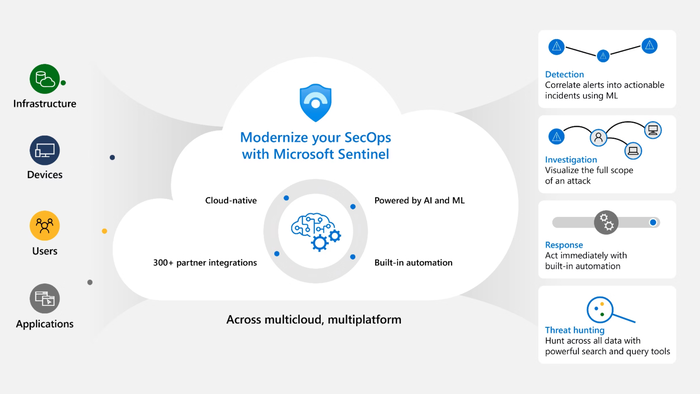15
+
YEARS OF
EXPERIENCE
1000
+
SUCCESSFUL
Projects
80
+
Satisfied
Clients

Microsoft Sentinel implementation is a strategic move for enterprises aiming to elevate their security posture in an increasingly complex digital world. As a scalable, cloud-native Security Information and Event Management (SIEM) solution, Microsoft Sentinel offers real-time threat intelligence, automated threat response, and deep analytics. This article explores the key facets of implementing Microsoft Sentinel, demonstrating how organizations can benefit from its advanced capabilities to safeguard critical infrastructure while optimizing operational costs.
Understanding Microsoft Sentinel Implementation: A Modern Approach to enterprise Security
Microsoft Sentinel implementation represents a transformative shift in how organizations monitor and respond to security threats. Unlike traditional SIEM systems, Microsoft Sentinel is built on Azure, offering cloud scalability, integration with various data sources, and AI-powered analytics. Implementation begins with defining clear objectives aligned with an organization’s security goals and compliance requirements. The process involves onboarding diverse log sources such as endpoints, servers, cloud services, and network devices into Sentinel for extensive visibility.
Key components include setting up data connectors, customizing workbooks and dashboards for visual insights, and configuring automation rules with playbooks for incident response. Additionally, leveraging threat intelligence feeds enables precise threat hunting and anomaly detection across the enterprise. Implementing Microsoft Sentinel also supports regulatory compliance by centralizing audit trails and simplifying reporting. By adopting Sentinel, businesses achieve not only enhanced security monitoring but also reduce the strain on IT teams through clever automation and streamlined workflows.







Critical Benefits and challenges of Microsoft Sentinel Implementation for IT Security Teams
Implementing Microsoft Sentinel delivers multiple benefits that align closely with modern cybersecurity demands. First and foremost, Sentinel’s cloud-native architecture ensures elasticity, allowing organizations to scale their monitoring capabilities effortlessly without heavy upfront investments in hardware or software. This adaptability makes it an optimal choice for businesses undergoing digital transformation or migrating workloads to the cloud. Another meaningful advantage is Sentinel’s integration with Microsoft Defender, Azure Security Center, and third-party tools, creating a unified security ecosystem for holistic threat detection.
Furthermore, Sentinel incorporates advanced artificial intelligence algorithms that automate anomaly detection, reducing false positives and accelerating incident response times. Automated playbooks enable IT teams to establish customized workflows, ensuring swift remediation actions are taken once threats are identified-minimizing business disruption. Despite these benefits, Sentinel implementation can pose challenges such as the need for initial configuration expertise, defining relevant use cases, and handling large volumes of data effectively. Organizations may encounter a learning curve when adopting new automation frameworks or managing log ingestion costs in line with data retention policies.
Partnering with seasoned experts like Cloud Technologies mitigates these obstacles by providing strategic guidance, tailored architecture design, and ongoing support. We assist clients in optimizing Sentinel configurations that balance comprehensive coverage with cost-efficiency, ensuring they derive maximum ROI from their security investments. Additionally, our proactive threat hunting services help uncover latent risks that traditional monitoring might miss, keeping organizations ahead of evolving cyber threats with Microsoft Sentinel implementation.

With Cloud Technologies’ expertise, clients benefit from a streamlined Microsoft sentinel implementation that addresses real-world security challenges. Our approach ensures that your organization not only adopts cutting-edge SIEM capabilities but also capitalizes on seamless integration and tailored automation to strengthen overall resilience against cyberattacks.
Real-World Microsoft Sentinel Implementation: Case Studies and Strategic Insights
Organizations across sectors, from finance to healthcare, have leveraged Microsoft Sentinel to bolster their cybersecurity frameworks. One notable case involved a multinational financial institution seeking enhanced threat visibility across hybrid cloud and on-premises environments. Cloud Technologies guided the implementation process, integrating Sentinel with existing security infrastructure, including Azure Active Directory and third-party firewall systems. This integration delivered unified monitoring and enabled rapid detection of unusual login attempts, insider threats, and advanced persistent threats (APT). through custom playbooks, the client automated responses to suspected incidents, cutting their average detection-to-remediation time by 40%.
In another scenario, a healthcare provider needed to streamline compliance with stringent regulations such as HIPAA while defending against ransomware attacks. Implementing Sentinel allowed continuous auditing of sensitive patient data access and anomaly detection, flagging potential breaches before data exfiltration could occur. The solution’s intuitive dashboards provided health administrators with real-time visibility into security posture, facilitating informed decision-making.
These successful implementations underscore the importance of a methodical Microsoft Sentinel approach that includes thorough requirements analysis, continuous tuning of detection rules, and staff training. Leveraging Sentinel’s flexible API architecture, organizations can extend its capabilities by integrating custom threat intelligence or third-party forensic tools, enhancing situational awareness. By partnering with Cloud Technologies, enterprises receive ongoing consultancy that adapts to their evolving security landscape, ensuring Microsoft Sentinel implementation is not a one-time project but a continuous journey toward cyber resilience.

answer time
satisfaction
score
on initial call
same business
day
Empowering Your Enterprise with Intelligent Microsoft Sentinel Implementation
In today’s dynamic threat habitat, implementing Microsoft Sentinel offers organizations a strategic advantage by providing a comprehensive, AI-driven security information and event management platform. This article highlighted how TechCloud IT Services L.L.C, trading as Cloud technologies, delivers expert guidance to ensure Microsoft Sentinel implementation drives measurable improvements in threat detection and response efficiency. By embracing Sentinel’s flexible and scalable design, businesses can proactively protect their digital assets while optimizing operational workflows and maintaining compliance.
To unlock the full potential of Microsoft Sentinel, it is vital to partner with a trusted provider that understands both the technology and your organization’s unique challenges. Cloud Technologies specializes in tailoring solutions that integrate seamlessly with your existing ecosystem, enabling intelligent automation and enhancing your security posture. Ready to modernize your cybersecurity framework and stay ahead of emerging threats? We invite you to connect with us to discuss your Microsoft Sentinel implementation needs and chart a secure path forward.
Contact us today to transform your security operations with precision and confidence.


